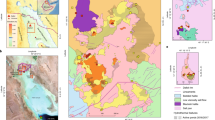Abstract
Subterranean salt deposits are the remains of ancient hypersaline waters that presumably supported dense populations of halophilic microorganisms including representatives of the haloarchaea (halobacteria). Ancient subterranean salt deposits (evaporites) are common throughout the world, and the majority sampled to date appear to support diverse populations of halobacteria. The inaccessibility of deep subsurface deposits, and the special requirements of these organisms for survival, make contamination by halobacteria from surface sites unlikely. It is conceivable that these subterranean halobacteria are autochthonous, presumably relict populations derived from ancient hypersaline seas that have been revived from a state of dormancy. One would predict that halobacteria that have been insulated and isolated inside ancient evaporites would be different from comparable bacteria from surface environments, and that it might be possible to use a molecular chronometer to establish if the evolutionary position of the subsurface isolates correlated with the geological age of the evaporite. Extensive comparisons have been made between the 16S rRNA genes of surface and subsurface halobacteria without showing any conclusive differences between the two groups. A further phylogenetic comparison exploits an unusual feature of one particular group of halobacteria that possess at least two heterogeneous copies of the 16S rRNA gene, the sequences of which may have been converging or diverging over geological time. However, results to date have yet to show any gene sequence differences between surface and evaporite-derived halobacteria that might arguably be an indication of long-term dormancy.
Similar content being viewed by others
Author information
Authors and Affiliations
Additional information
Received: January 22, 1998 / Accepted: February 16, 1998
Rights and permissions
About this article
Cite this article
Grant, W., Gemmell, R. & McGenity, T. Halobacteria: the evidence for longevity. Extremophiles 2, 279–287 (1998). https://doi.org/10.1007/s007920050070
Issue Date:
DOI: https://doi.org/10.1007/s007920050070




